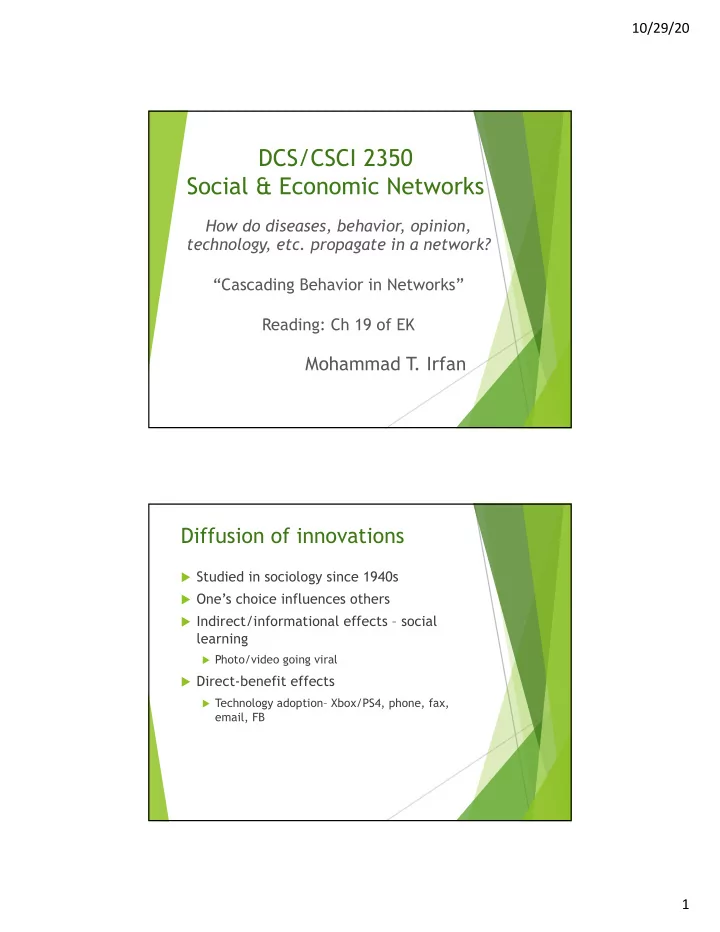

10/29/20 DCS/CSCI 2350 Social & Economic Networks How do diseases, behavior, opinion, technology, etc. propagate in a network? “Cascading Behavior in Networks” Reading: Ch 19 of EK Mohammad T . Irfan Diffusion of innovations u Studied in sociology since 1940s u One’s choice influences others u Indirect/informational effects – social learning u Photo/video going viral u Direct-benefit effects u Technology adoption– Xbox/PS4, phone, fax, email, FB 1
10/29/20 Examples u Adoption of hybrid seed corn in Iowa u Ryan and Gross, 1943 u Adoption of tetracycline by US doctors u Coleman, Katz, and Menzel, 1966 u Shared ingredients u Indirect effects u Adoption was high-risk, high-gain u Early adopters had higher socioeconomic status u Social structure was important– visibility of neighbors’ activity Diffusion of Innovations – Everett Success Rogers (1995) u Complexity factors of u Observability diffusion u Trialability u Compatibility 2
10/29/20 #TheDress (February 2015) 3
10/29/20 Next u Modeling diffusion u Connection with the things we know u Homophily u Clustering u The strength of weak ties Threshold models for diffusion 4
10/29/20 Precursor– Granovetter's model u Mark Granovetter's threshold model of collective behavior (1978) u Side note: collective behavior vs. collective action u Model: An individual will adopt action A if at least a certain number (threshold) of other individuals adopt A Granovetter's model u Example u Emergence of a riot in a crowd of 100 people (complete graph) u Thresholds of individuals to get violent u 0, 1, 2, ..., 99 Extremely important that u What will happen? someone has a threshold u Extensions of 0. Why? u General network u Distribution of thresholds u Difference with Schelling's model: In Granovetter's model, slight change of thresholds may lead to completely different global outcome. 5
10/29/20 Contagion Model Stephen Morris, 2000 Contagion model u Explicitly model direct-benefit effect u "Networked coordination game" u Model u 2 choices– A (Slack) and B (Skype) u “Payoffs” of any two friends v & w in a network u Payoffs are interdependent u Each individual wants to get the maximum possible payoff subject to what others are doing 6
10/29/20 Contagion model (cont...) u What action will v adopt (A or B)? v will adopt A if: p fraction of v's friends: A p >= b/(a+b) (1-p) fraction: B Threshold, q = b/(a+b) Degree of v = d for switching from B to A Initial adopters u Facilitates diffusion u Granovetter's model: the persons with threshold = 0 are the initial adopters vs. We can set initial adopters without any regard for their threshold u Modeling assumption by Kleinberg & many others 7
10/29/20 Example: switching from B to A u Initially everyone does B u Payoff parameters: b = 2, a = 3 u Threshold for switching from B to A, q = 2/5 u We will set two initial adopters of A and "play out" the diffusion 8
10/29/20 Complete cascade u Def. A set of initial adopters causes a "complete cascade" if everyone adopts the new action at the end of diffusion. u Always happens? 9
10/29/20 What are the factors for a widespread diffusion? u Initial adopters u Network structure u Threshold value q u Quality of product– payoff parameters a and b u Example: viral marketing Diffusion vs. strength of weak ties u Weak ties are conveyors of information u But cannot “force” adoption of behavior Would Align with own community 10
10/29/20 Diffusion vs. clustering u Does clustering help diffusion? Every node in these clusters have at most 1/3 fraction of friends outside. Will they ever adopt the new behavior? Diffusion vs. clustering u Assuming a threshold of q, cascade will be incomplete if and only if there is a cluster of density > 1-q in the “remaining network” u Cluster density: minimum over the nodes in a cluster {fraction of neighbors of the node that belong to the same cluster} density = 2/3 > 1-q for q = 2/5 11
10/29/20 More general models Cascades with heterogeneous thresholds u Node v’s threshold = b v /(a v + b v ) u Same calculation as before 12
10/29/20 Further extension: linear threshold model u All friendships are not the same! => influence 13
10/29/20 Influence games (Irfan & Ortiz, 2014) u Thresholds are heterogeneous u Directed, asymmetric network u Relationships can be positive or negative (gradation of "influence" is also allowed) u Switching back and forth two actions are allowed u Initial adopters or seed nodes Granovetter: Kleinberg: seeds must have seeds can be externally threshold 0 set (their thresholds don't matter) What can go wrong? We: seeds can be externally set as long as their threshold requirements are fulfilled at the end of diffusion 14
Recommend
More recommend